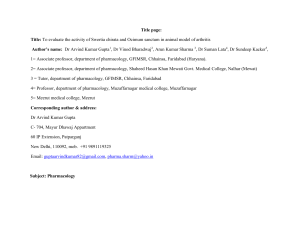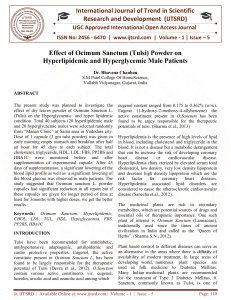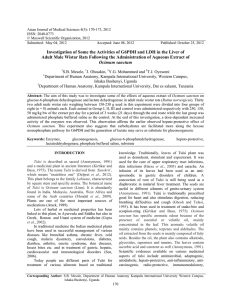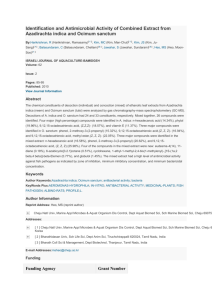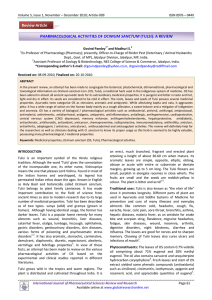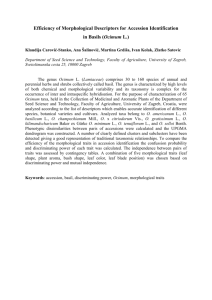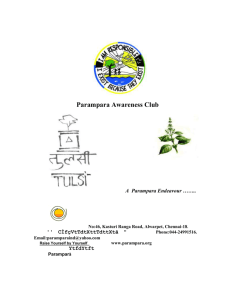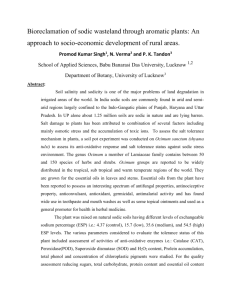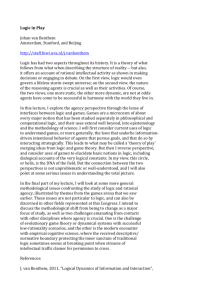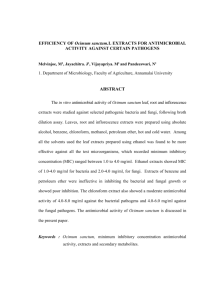Document 13308465
advertisement
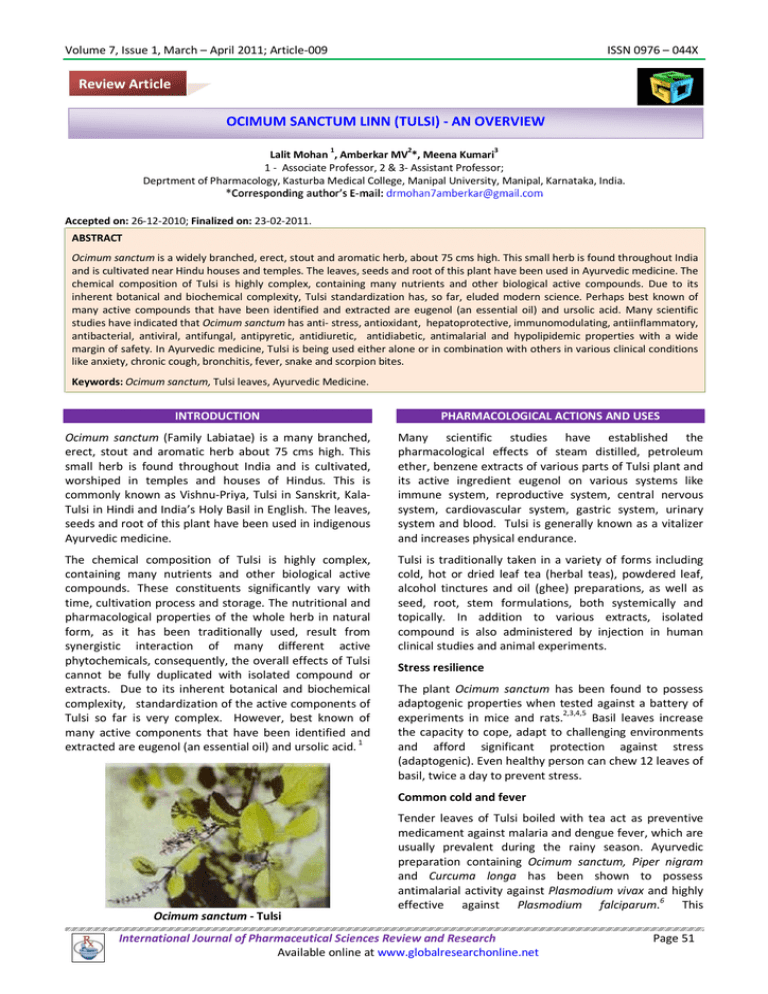
Volume 7, Issue 1, March – April 2011; Article-009 ISSN 0976 – 044X Review Article OCIMUM SANCTUM LINN (TULSI) - AN OVERVIEW 1 2 3 Lalit Mohan , Amberkar MV *, Meena Kumari 1 - Associate Professor, 2 & 3- Assistant Professor; Deprtment of Pharmacology, Kasturba Medical College, Manipal University, Manipal, Karnataka, India. Accepted on: 26-12-2010; Finalized on: 23-02-2011. ABSTRACT Ocimum sanctum is a widely branched, erect, stout and aromatic herb, about 75 cms high. This small herb is found throughout India and is cultivated near Hindu houses and temples. The leaves, seeds and root of this plant have been used in Ayurvedic medicine. The chemical composition of Tulsi is highly complex, containing many nutrients and other biological active compounds. Due to its inherent botanical and biochemical complexity, Tulsi standardization has, so far, eluded modern science. Perhaps best known of many active compounds that have been identified and extracted are eugenol (an essential oil) and ursolic acid. Many scientific studies have indicated that Ocimum sanctum has anti- stress, antioxidant, hepatoprotective, immunomodulating, antiinflammatory, antibacterial, antiviral, antifungal, antipyretic, antidiuretic, antidiabetic, antimalarial and hypolipidemic properties with a wide margin of safety. In Ayurvedic medicine, Tulsi is being used either alone or in combination with others in various clinical conditions like anxiety, chronic cough, bronchitis, fever, snake and scorpion bites. Keywords: Ocimum sanctum, Tulsi leaves, Ayurvedic Medicine. INTRODUCTION PHARMACOLOGICAL ACTIONS AND USES Ocimum sanctum (Family Labiatae) is a many branched, erect, stout and aromatic herb about 75 cms high. This small herb is found throughout India and is cultivated, worshiped in temples and houses of Hindus. This is commonly known as Vishnu-Priya, Tulsi in Sanskrit, KalaTulsi in Hindi and India’s Holy Basil in English. The leaves, seeds and root of this plant have been used in indigenous Ayurvedic medicine. Many scientific studies have established the pharmacological effects of steam distilled, petroleum ether, benzene extracts of various parts of Tulsi plant and its active ingredient eugenol on various systems like immune system, reproductive system, central nervous system, cardiovascular system, gastric system, urinary system and blood. Tulsi is generally known as a vitalizer and increases physical endurance. The chemical composition of Tulsi is highly complex, containing many nutrients and other biological active compounds. These constituents significantly vary with time, cultivation process and storage. The nutritional and pharmacological properties of the whole herb in natural form, as it has been traditionally used, result from synergistic interaction of many different active phytochemicals, consequently, the overall effects of Tulsi cannot be fully duplicated with isolated compound or extracts. Due to its inherent botanical and biochemical complexity, standardization of the active components of Tulsi so far is very complex. However, best known of many active components that have been identified and extracted are eugenol (an essential oil) and ursolic acid. 1 Tulsi is traditionally taken in a variety of forms including cold, hot or dried leaf tea (herbal teas), powdered leaf, alcohol tinctures and oil (ghee) preparations, as well as seed, root, stem formulations, both systemically and topically. In addition to various extracts, isolated compound is also administered by injection in human clinical studies and animal experiments. Stress resilience The plant Ocimum sanctum has been found to possess adaptogenic properties when tested against a battery of 2,3,4,5 experiments in mice and rats. Basil leaves increase the capacity to cope, adapt to challenging environments and afford significant protection against stress (adaptogenic). Even healthy person can chew 12 leaves of basil, twice a day to prevent stress. Common cold and fever Ocimum sanctum - Tulsi Tender leaves of Tulsi boiled with tea act as preventive medicament against malaria and dengue fever, which are usually prevalent during the rainy season. Ayurvedic preparation containing Ocimum sanctum, Piper nigram and Curcuma longa has been shown to possess antimalarial activity against Plasmodium vivax and highly effective against Plasmodium falciparum.6 This International Journal of Pharmaceutical Sciences Review and Research Available online at www.globalresearchonline.net Page 51 Volume 7, Issue 1, March – April 2011; Article-009 preparation has been found to relieve the malarial clinical symptoms caused by these species. A decoction prepared from the roots of Tulsi plant is used as a diaphoretic in 7 malarial fever. Tulsi is important constituent of many Ayurvedic cough syrups and expectorants. It helps to mobilize mucus in bronchitis and asthma. Chewing Tulsi leaves relieve cold and flu like symptoms. ISSN 0976 – 044X profile, providing safe beneficial effects at low doses without any undesirable side effects. In Ayurvedic medicine, Tulsi has therapeutic potential either alone or in combination with other plants in various clinical conditions like eye disorders (glaucoma, cataract, & chronic conjunctivitis), catalepsy, snake and scorpion bites etc .4, 6, 13 Antibiotic property Essential oils extracted from the leaves of Ocimum sanctum L. has been found to inhibit growth of E. coli, B. anthracis and P. aeruginosa in-vitro, showing its antibacterial activity. Ocimum sanctum also possesses antifungal activity against Asperigillus niger and aqueous extract of it was found to be effective in patients suffering from viral encephalitis.6 In the treatment of ring worm infections, Tulsi leaves paste is indeed found to be very effective. Tulsi has significant natural antibacterial, antiviral and antifungal activities and is helpful in treating many serious systemic diseases, as well as localized infections. Hypoglycemic, properties Hypolipidemic and Antioxidant The aqueous extract of Ocimum sanctum (Tulsi) mixed with diet for eight weeks to diabetic (streptozotocin induced) rats were studied. There was significant reduction in fasting blood glucose, serum lipid profile, lipid peroxidation products, and improvement in glucose tolerance. The aqueous extract also decreased LPO formation (thiobarbituric acid reactive substances TBARS) and increased antioxidant enzymes like superoxide dismutase (SOD), catalase (CAT), glutathione peroxidase (GPX), glutathione transferases (GT). It also increased antioxidant like reduced glutathione (GSH) levels in plasma and liver, lung, kidney and brain of rat.8 Tulsi has been found to have therapeutic potential as antidiabetic, hypolipidemic, and antioxidant medicine. Hepatoprotective, Renoprotective and Neuroprotective activities Ocimum sanctum leaf extract was found to be hepatoprotective against hepatotoxic paracetamol by significant reduction of serum enzymes aspartate aminotransferase (AST), alanine aminotransferase (ALT), alkaline phosphatase (ALP) in rats and also showed marked reduction in fatty degeneration of liver on histopathological examination.9 Administration of combination of Ocimum sanctum aqueous leaf extract and gentamicin, significantly prevented rise in levels of serum creatinine and blood urea when compared to the gentamicin only treated group in rats.10 Leaves and seeds of Tulsi plant have been reported to reduce blood and urinary uric acid level in albino rabbits and also possessed 11 diuretic property. Ocimum sanctum leaf extract prevents stress induced dendritic deficiency in hippocampal neurons in albino rats.12 Research indicate that Tulsi has a very high safety margin and very low toxic CONCLUSION Tulsi is a common herb grown in many households with a wide range of therapeutic properties. It would be a blessing in disguise if this herb becomes a medicine for the common man. Still more clinical trials need to be conducted to support its medicinal therapeutic uses. REFERENCES 1. Miller R and Miller S. Tulsi green and Herbs. India’s Holy Basil. htpp://www.omorganic.com/ tulsi 23J03:1-6. 2. Bhargava KP, Singh N. Antistress activity of Ocimum sanctum linn. Indian J Med Res. 1981; 73: 443-451. 3. Dadkar VN, Joshi AG, Jaguste VS, Billimoria FR, Dhar HL. Anti stress activity of Ocimum sanctum (Tulsi). Indian Drugs 1988; 25(5): 172-175. 4. Sen P, Maiti PC, Puri S, Ray A, Audulov NA and Valdman AV. Mechanism of anti-stress activity of Ocimum sanctum Linn Eugenol and Tinospora malabarica in experimental animals. Indian J Exp Biol. 1992; 30 (7): 592-596. 5. Tabassum I, Siddiqui Z N, Rizvi S J. Effects of Ocimum sanctum and Camellia sinensis on stressinduced anxiety and depression in male albino Rattus norvegicus. Indian j pharmacol. 2010; 42 (5): 283-288. 6. Ocimum sanctum. The Indian home remedy. In: Current Medical Scene, March-April 1992 (Edited and published by S. Rajeshwari, Cipla Ltd., BombayCentral, Bombay). 7. Pandey BP, Anita. In: Economic Botany (Published by Chand and Company Ltd., Ramnagar, New Delhi), p. 294, 1990. 8. Hussain EHMA, Jamil K and Rao M. Hypoglycemic, hypolipidemic and antioxidant properties of Tulsi (Ocimum sanctum) on streptozotocin induced diabetes in rats. Indian J of Clin Biochemistry, 2001; 16(2): 190-194. 9. Chattopadhay RR, Sarkar SK, Ganguly S, Medda C and Bassu TK. Hepatoprotectivity activity of Ocimum sanctum leaf extract against paracetamol induced hepatic damage in rats. Indian J Pharmacol. 1992; 24: 163-165. 10. Muglikar AG, Kothekar MA, Chilwant KS and Jaju JB. Effect of Ocimum sanctum (OS) aqueous leaf extract International Journal of Pharmaceutical Sciences Review and Research Available online at www.globalresearchonline.net Page 52 Volume 7, Issue 1, March – April 2011; Article-009 ISSN 0976 – 044X on gentamicin induced nephrotoxicity in rats. Indian J Pharmacol. 2004; 36(2): 123. to the hippocampal CA-3 neurons in the rats. J Anat Soc India. 2001; 50(1): 70. 11. Sarkar A, Pandey DN, Pant MC. A report on the effect of Ocimum sanctum (Tulsi) leaves and seeds on blood and urinary uric acid, urea and urine volume in normal albino rabbits. Indian J Physiol Pharmacology. 1990; 34: 61–62. 13. Nair V, Albina A, Dorababu P, Gopalakrishna HN, Rao C U and Mohan L. Effect of NR-ANX-C (a polyherbal formulation) on haloperidol induced catalepsy in albino mice. Indian J Med Res. 2007; 126: 480-484. 12. Rodrigues V, Rao MS, Satish N, and Rao GM. Ocimum sanctum prevents stress induced damage About Corresponding Author: Dr. Amberkar MV Dr. Amberkar Mohan babu V, working at Kasturba Medical College, Manipal and post graduated from Manipal University. He is having 8 years of teaching experience, handled many research projects and publications. Presently working as Asst. professor, guiding under graduate and post graduate medical students. His area of interest is cardiovascular system and neurodegenerative disorders. International Journal of Pharmaceutical Sciences Review and Research Available online at www.globalresearchonline.net Page 53
